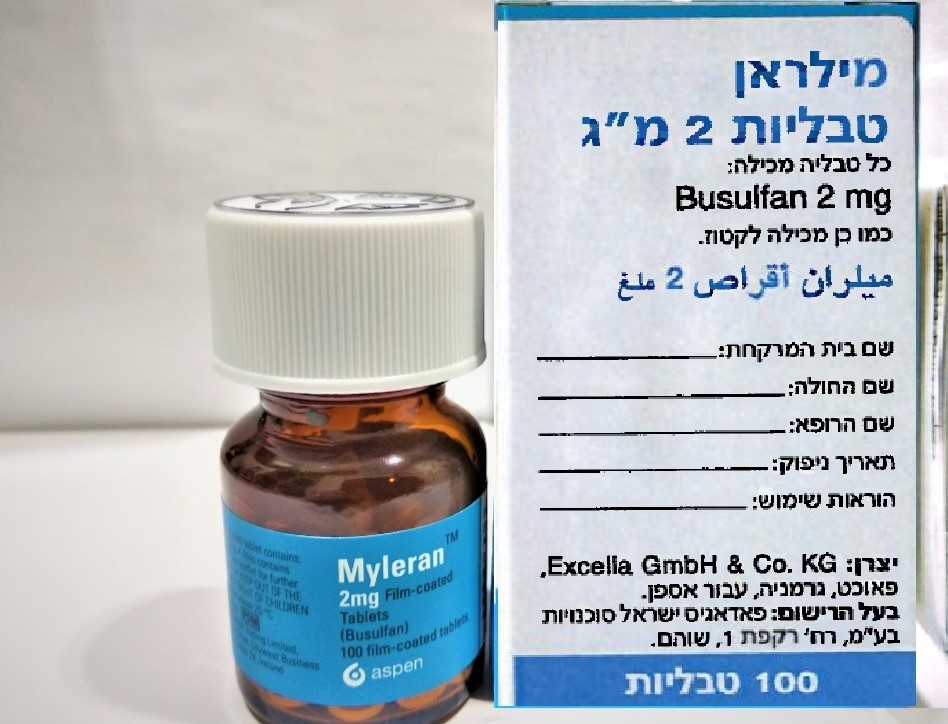Quest for the right Drug

מילראן טבליות 2 מ"ג MYLERAN TABLETS 2 MG (BUSULFAN)
תרופה במרשם
תרופה בסל
נרקוטיקה
ציטוטוקסיקה
צורת מתן:
פומי : PER OS
צורת מינון:
טבליה : TABLETS
עלון לרופא
מינוניםPosology התוויות
Indications תופעות לוואי
Adverse reactions התוויות נגד
Contraindications אינטראקציות
Interactions מינון יתר
Overdose הריון/הנקה
Pregnancy & Lactation אוכלוסיות מיוחדות
Special populations תכונות פרמקולוגיות
Pharmacological properties מידע רוקחי
Pharmaceutical particulars אזהרת שימוש
Special Warning עלון לרופא
Physicians Leaflet
Special Warning : אזהרת שימוש
4.4 Special warnings and precautions for use Busulfan is an active cytotoxic agent for use only under the direction of physicians experienced in the administration of such agents. Immunisation using a live organism vaccine has the potential to cause infection in immunocompromised hosts. Therefore, immunisations with live organism vaccines are not recommended. Myleran should be discontinued if lung toxicity develops (see section 4.8). Myleran should not generally be given in conjunction with or soon after radiotherapy. Myleran is ineffective once blast transformation has occurred. If anaesthesia is required in patients with possible pulmonary toxicity, the concentration of inspired oxygen should be kept as low as safely as possible and careful attention given to post-operative respiratory care. Hyperuricaemia and/or hyperuricosuria are not uncommon in patients with chronic granulocytic leukaemia and should be corrected before starting treatment with Myleran. During treatment, hyperuricaemia and the risk of uric acid nephropathy should be prevented by adequate prophylaxis, including adequate hydration and the use of allopurinol. Studies in renally impaired patients have not been conducted, however, as busulfan is moderately excreted in the urine, dose modification is not recommended in these patients. However, caution is recommended. Busulfan has not been studied in patients with hepatic impairment. Since busulfan is mainly metabolized through the liver, caution should be observed when busulfan is used in patients with pre-existing impairment of liver function, especially in those with severe hepatic impairment. The medicinal product contains lactose. Patients with rare hereditary problems of galactose intolerance, the Lapp lactase deficiency or glucose-galactose malabsorption should not take this medicine. Conventional dose Treatment Patients who are concurrently treated with the conventional dose of busulfan and itraconazole or metronidazole should be closely monitored for signs of busulfan toxicity. At concomitant use of these agents with busulfan weekly blood counts are recommended (see section 4.5). Monitoring Careful attention must be paid to monitoring the blood counts throughout treatment to avoid the possibility of excessive myelosuppression and the risk of irreversible bone marrow aplasia (see section 4.8). Hepatic veno-occlusive disease is a major complication that can occur during treatment with Myleran. Patients who have received prior radiation therapy, for three or more cycles of chemotherapy, or prior progenitor cell transplant may be at an increased risk of developing hepatic veno-occlusive disease (see section 4.8). Safe Handling of Myleran Tablets See section 6.6. Myleran is genotoxic in non-clinical studies (see section 5.3). Mutagenicity Various chromosome aberrations have been noted in cells from patients receiving busulfan. Carcinogenicity On the basis of human studies, Myleran was considered by the International Agency for Research on cancer to show sufficient evidence for carcinogenicity. The World Health Association has concluded that there is a causal relationship between Myleran exposure and cancer. Widespread epithelial dysplasia has been observed in patients treated with long-term Myleran, with some of the changes resembling precancerous lesions. A number of malignant tumours have been reported in patients who have received Myleran treatment. The evidence is growing that Myleran, in common with other alkylating agents, is leukaemogenic. In a controlled prospective study in which 2 years' Myleran treatment was given as an adjuvant to surgery for lung cancer, long-term follow-up showed an increased incidence of acute leukaemia compared with the placebo-treated group. The incidence of solid tumours was not increased. Although acute leukaemia is probably part of the natural history of polycythaemia vera, prolonged alkylating agent therapy may increase the incidence.
Effects on Driving
4.7 Effects on ability to drive and use machines There are no data on the effect of Myleran on driving performance or the ability to operate machinery. A detrimental effect on these activities cannot be predicted from the pharmacology of the drug.

שימוש לפי פנקס קופ''ח כללית 1994
Chronic myelogenous leukemia and myeloproliferative disorders
תאריך הכללה מקורי בסל
01/01/1995
הגבלות
תרופה שאושרה לשימוש כללי בקופ'ח
מידע נוסף
עלון מידע לצרכן
26.02.20 - עלון לצרכן אנגלית 26.02.20 - עלון לצרכן עברית 26.02.20 - עלון לצרכן ערבית 12.10.22 - עלון לצרכן אנגלית 12.10.22 - עלון לצרכן עברית 12.10.22 - עלון לצרכן ערבית 23.03.24 - עלון לצרכן עברית 15.07.24 - עלון לצרכן אנגלית 15.07.24 - עלון לצרכן עברית 15.07.24 - עלון לצרכן ערבית 13.05.12 - החמרה לעלון 18.06.14 - החמרה לעלון 20.12.16 - החמרה לעלון 03.07.19 - החמרה לעלון 26.02.20 - החמרה לעלון 12.10.22 - החמרה לעלון 23.03.24 - החמרה לעלוןלתרופה במאגר משרד הבריאות
מילראן טבליות 2 מ"ג